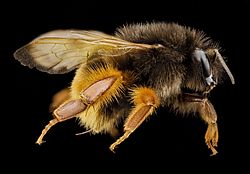Bombus eximius
| Bombus eximius | |
 | |
| Systematik | |
|---|---|
| Domän | Eukaryoter Eukaryota |
| Rike | Djur Animalia |
| Stam | Leddjur Arthropoda |
| Understam | Sexfotingar Hexapoda |
| Klass | Insekter Insecta |
| Ordning | Steklar Hymenoptera |
| Underordning | Midjesteklar Apocrita |
| (orankad) | Gaddsteklar Aculeata |
| Överfamilj | Bin Apoidea |
| Familj | Långtungebin Apidae |
| Släkte | Humlor Bombus |
| Undersläkte | Melanobombus[1] |
| Art | B. eximius |
| Vetenskapligt namn | |
| § Bombus eximius | |
| Auktor | Smith, 1852[2] |
| Synonymer | |
Bombus latissimus Friese, 1910[3] | |
| Hitta fler artiklar om djur med | |
Bombus eximius (saknar svenskt namn) är en insekt i överfamiljen bin (Apoidea) och släktet humlor (Bombus)[3] som lever i Central- och Sydasien[4].
Beskrivning
Arten är en stor humla (speciellt drottningen) med rödbruna vingar och medellång tunga. Drottningen blir 28 till 29 mm lång, arbetarna 14 till 19 mm, och hanarna 18 till 19 mm. Huvud och mellankropp är svarta, första tergiten[a] orange till ljusbrunt, andra tergiten (och tredje hos honorna) huvudsakligen svart, och resten av bakkroppen orange.[4] Det finns även helsvarta exemplar, och individer med endast någon enstaka orange markering på bakkroppen. De två bakre benparen är dock alltid orangefärgade.[5]
Ekologi
Bombus eximius är en ovanlig art som förekommer på förhållandevis låg höjd (450 till 1 200 m) i bergsområden.[4] Flygtiden varar från slutet av april till slutet av juli.[6]
Utbredning
Bombus eximius finns i Himalaya, Myanmar, Thailand, Vietnam, Tibet, de kinesiska provinserna Yunnan, Sichuan, Fujian, Jiangxi, Guangdong, Guangxi och Guizhou samt Taiwan.[4] Den har även påträffats i Japan (1929)[7].
Kommentarer
Källor
- ^ ”Melanobombus” (på engelska). Natural History Museum, London. http://www.nhm.ac.uk/research-curation/research/projects/bombus/ml.html. Läst 12 januari 2015.
- ^ ”Bombus eximius Smith, 1852” (på engelska). Discover Life. http://www.discoverlife.org/mp/20q?search=Bombus+eximius. Läst 3 juni 2010.
- ^ [a b c d e f g h i j k l] ”Bombus eximius Smith, 1852” (på engelska). Integrated Taxonomic Information System (ITIS). https://www.itis.gov/servlet/SingleRpt/SingleRpt?search_topic=TSN&search_value=714900#null. Läst 16 juli 2024.
- ^ [a b c d] Paul Williams, Ya Tang, Jian Yao & Sydney Cameron (2008). ”The bumblebees of Sichuan (Hymenoptera: Apidae, Bombini)” (på engelska) (PDF, 9,31 MB). Systematics and Biodiversity. University of Illinois. sid. 10, 71-72. doi:. http://www.life.illinois.edu/scameron/pdfs/Williams&al09_Sichuan.pdf. Läst 5 april 2015.
- ^ Williams, Paul H.; Ito, Masao; Matsumura, Takeshi; Kudo, Iwao (2010). ”The bumblebees of the Nepal Himalaya (Hymenoptera :Apidae)” (PDF, 9,47 MB). Insecta matsumurana (Hokkaidos universitet) 66 (5): sid. 27. https://www.researchgate.net/profile/Paul-Williams-14/publication/49466487_The_bumblebees_of_the_Nepal_Himalaya_Hymenoptera_Apidae/links/0912f50a2726eb2f82000000/The-bumblebees-of-the-Nepal-Himalaya-Hymenoptera-Apidae.pdf?_tp=eyJjb250ZXh0Ijp7ImZpcnN0UGFnZSI6InB1YmxpY2F0aW9uIiwicGFnZSI6InB1YmxpY2F0aW9uIn19. Läst 5 april 2015.
- ^ Paul Williams, Ya Tang, Jian Yao & Sydney Cameron (2008). ”The bumblebees of Sichuan (Hymenoptera: Apidae, Bombini)”, sid. 37
- ^ ”Map of Bombus eximius” (på engelska). Discover Life. http://www.discoverlife.org/mp/20m?kind=Bombus+eximius. Läst 3 juni 2010.
|
Media som används på denna webbplats
A lovely slightly florescent orange bumble bee from Taiwan. So many combinations of color and form in each genus of bee!
13:55, 17 November 2014 (UTC)13:55, 17 November 2014 (UTC){{{{{{0}}}}}}13:55, 17 November 2014 (UTC)13:55, 17 November 2014 (UTC)
All photographs are public domain, feel free to download and use as you wish.
Photography Information: Canon Mark II 5D, Zerene Stacker, Stackshot Sled, 65mm Canon MP-E 1-5X macro lens, Twin Macro Flash in Styrofoam Cooler, F5.0, ISO 100, Shutter Speed 200
Further in Summer than the Birds
Pathetic from the Grass
A minor Nation celebrates
Its unobtrusive Mass.
No Ordinance be seen
So gradual the Grace
A pensive Custom it becomes
Enlarging Loneliness.
Antiquest felt at Noon
When August burning low
Arise this spectral Canticle
Repose to typify
Remit as yet no Grace
No Furrow on the Glow
Yet a Druidic Difference
Enhances Nature now
-- Emily Dickinson
Want some Useful Links to the Techniques We Use? Well now here you go Citizen:
Basic USGSBIML set up: www.youtube.com/watch?v=S-_yvIsucOY
USGSBIML Photoshopping Technique: Note that we now have added using the burn tool at 50% opacity set to shadows to clean up the halos that bleed into the black background from "hot" color sections of the picture.
www.youtube.com/watch?v=Bdmx_8zqvN4
PDF of Basic USGSBIML Photography Set Up:
ftp://ftpext.usgs.gov/pub/er/md/laurel/Droege/How%20to%20Take%20MacroPhotographs%20of%20Insects%20BIML%20Lab2.pdf
Google Hangout Demonstration of Techniques:
plus.google.com/events/c5569losvskrv2nu606ltof8odo
or
www.youtube.com/watch?v=4c15neFttoU
Excellent Technical Form on Stacking:
www.photomacrography.net/
Contact information: Sam Droege sdroege@usgs.gov
301 497 5840